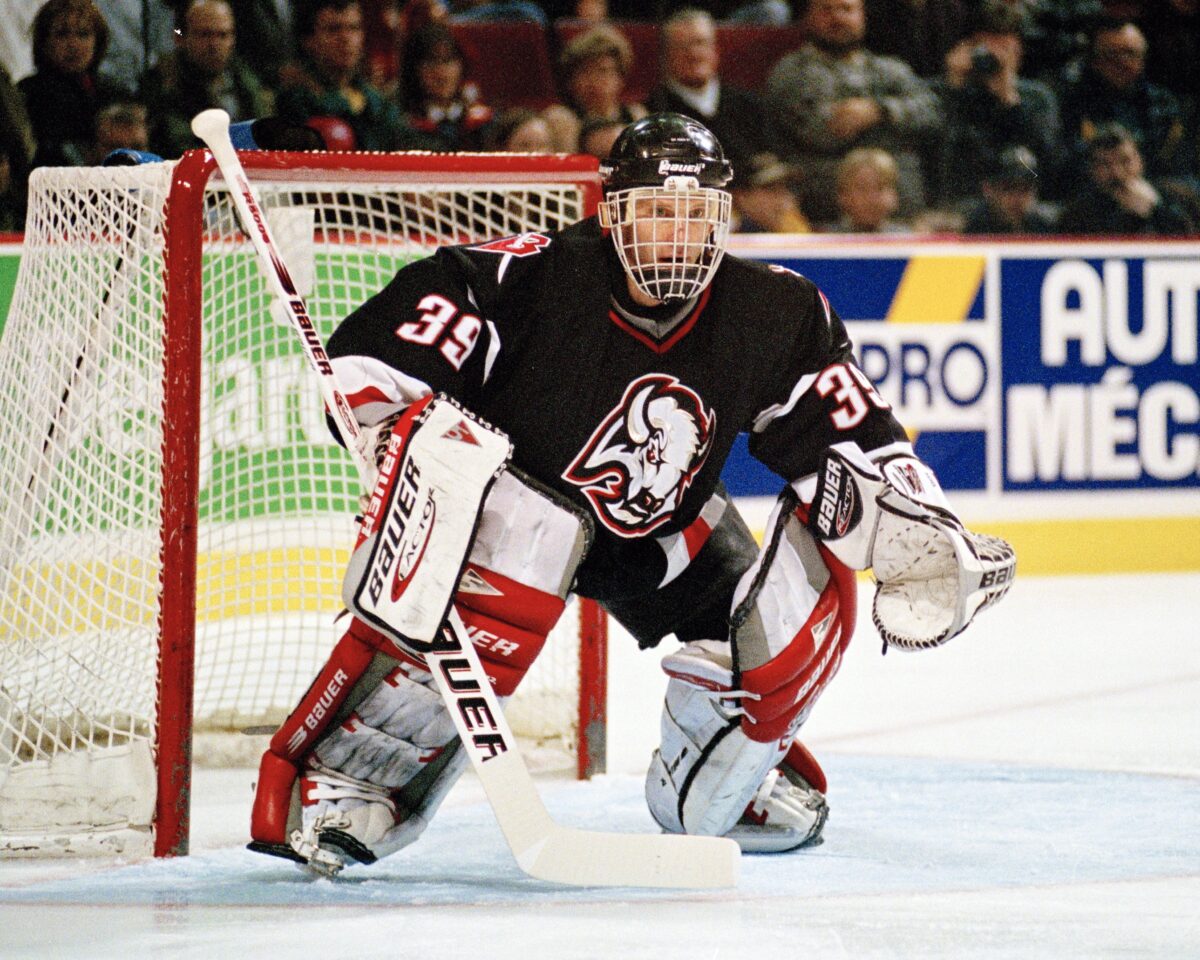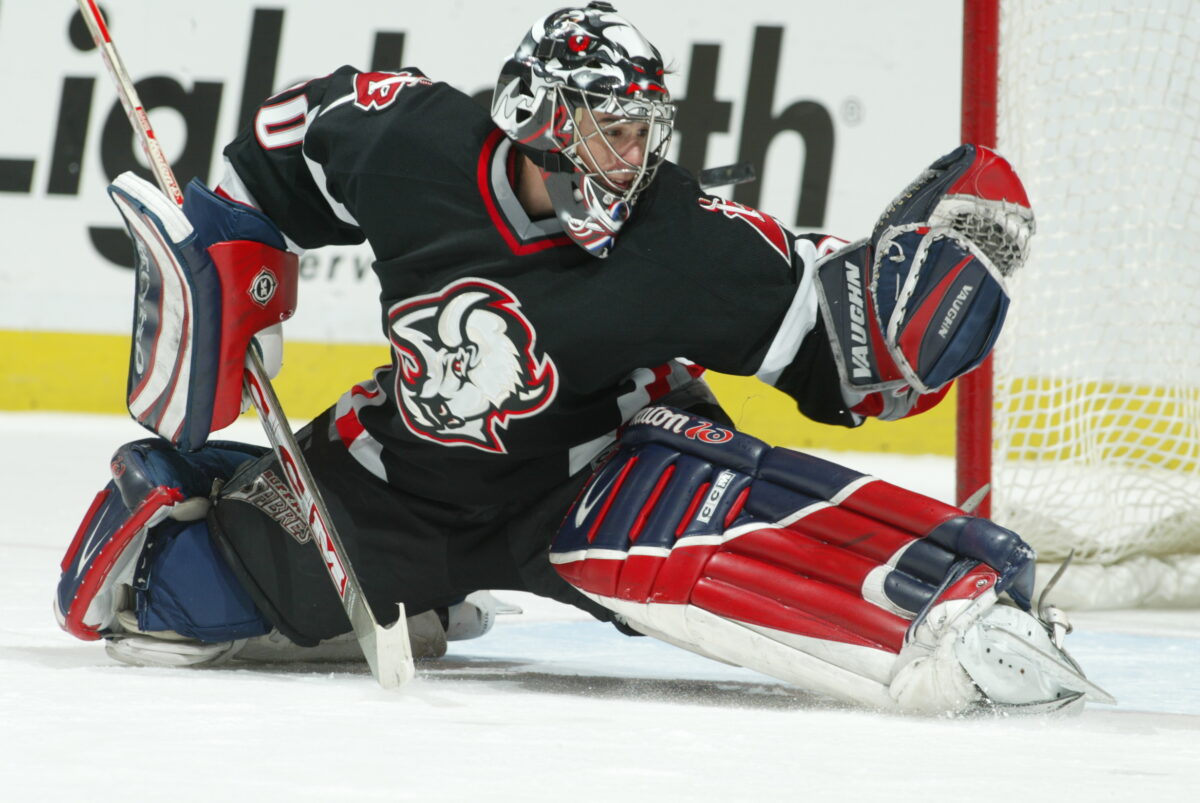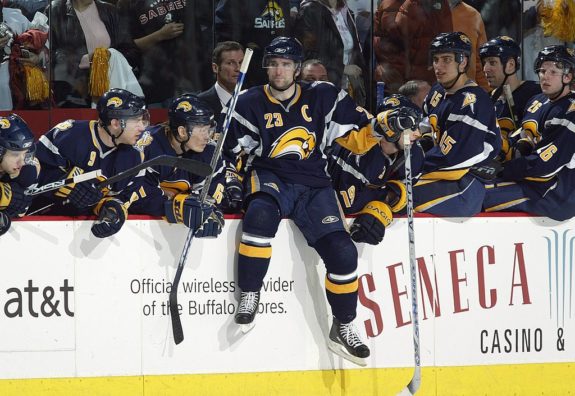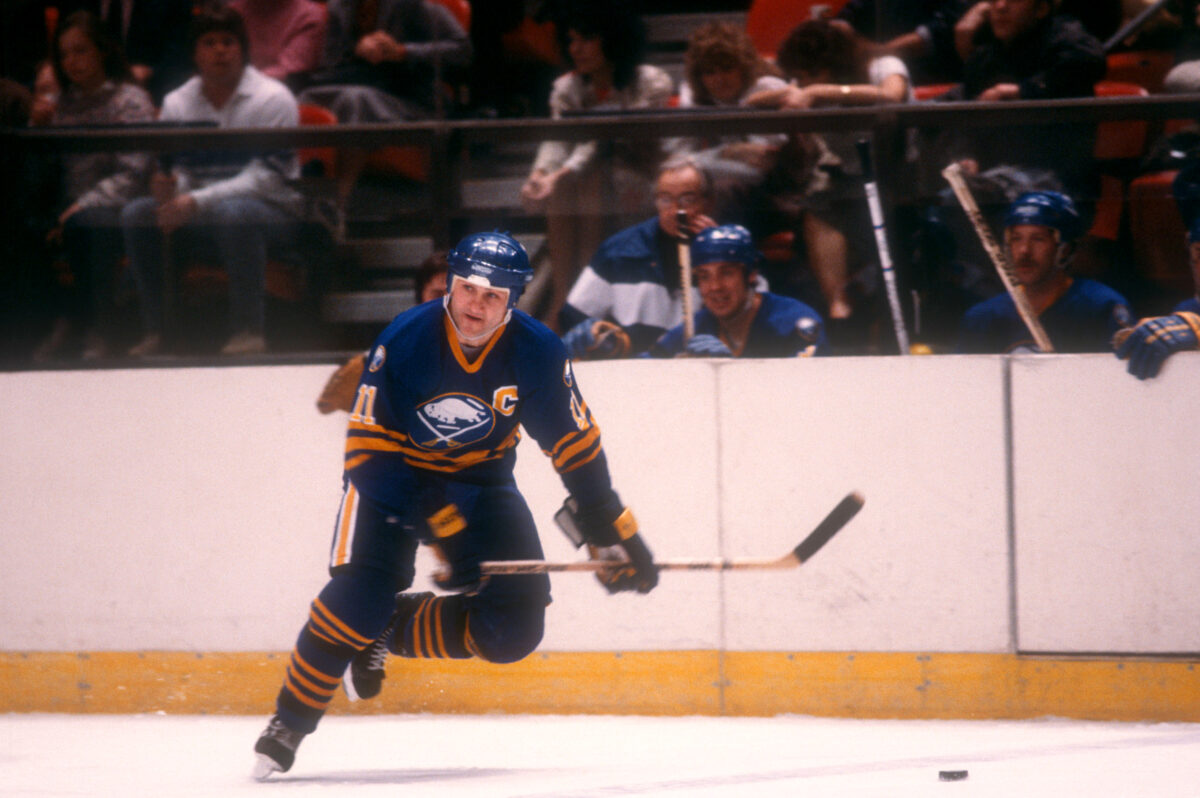The Buffalo Sabres have had plenty of ups and downs over their 43-year history. The franchise is looking to return to the playoffs after an NHL-record 12-year drought. Times have been tough recently, but it wasn’t always that way. For a team with no Stanley Cups to their name, they have had some remarkable groups. Here’s a look at the Sabres teams that almost captured that elusive first Cup.
4. 1998-99: No Goal
Unlike the other great teams on this list, the 1989-99 edition of the Sabres did not rely on offense to win games. In fact, they scored the least amount of goals of any playoff team in the Eastern Conference. This Sabres team knew how to lock things down and win 1-0 and 2-1 games. The man who made this style of play successful was goaltender Dominik Hasek. I consider him the greatest goalie of all time, and this season was one of the many reasons why. He posted a jaw-dropping .937 save percentage (SV%) in 64 games and won his fifth Vezina Trophy. The other personnel on the Sabres should be given credit for executing a structured defensive game, but make no mistake; they lived and died with their goaltending.
In the playoffs, Hasek raised his game to near super-human levels. He posted a .939 SV% and 1.77 goals-against average. The Sabres tore through the Ottawa Senators, Boston Bruins, and Toronto Maple Leafs to reach their second Stanley Cup Final.
In Game 6 of the Cup Final against the Dallas Stars, the Sabres faced elimination. The game went into triple overtime when Dallas scored one of the most controversial goals in NHL history.

Stars forward Brett Hull went to the net, collected a rebound off a scramble in the crease, and scored the Stanley Cup-winning goal in overtime. At the time, NHL rules stated that offensive players could not stand in the crease before scoring unless they had possession and control of the puck before entering the crease. Hull certainly had his foot in the crease, but whether he maintained possession was a grey area. While most Sabres fans will probably never agree, there wasn’t conclusive enough evidence to overturn it. The Sabres haven’t been back to the Stanley Cup Final since.
3. 2005-06: Scary Good
Coming off the notorious 2004-05 NHL lockout, the Sabres had a good, young team poised to do serious damage. In their first full seasons with the team, Thomas Vanek and Ryan Miller established themselves as key players for the Sabres. After significant departures a couple of seasons later, these two became the faces of the franchise.
The 2005-06 Sabres had ten forwards who scored over ten goals, making them one of the NHL’s deepest teams. Daniel Briere had a breakout season despite dealing with injuries, putting up 58 points in 48 games. With the youngsters making an impact and core players like Briere finding success, the Sabres finished second in the competitive Northeast Division with a 52-24-6 record.

After using their high-powered offense to defeat the Philadelphia Flyers in six games, Buffalo was up against their fierce division rivals, the Senators. The Sabres won a wild 7-6 game in overtime, then both teams settled down and played tight, low-scoring games the rest of the series. The most iconic moment of the Season for the Sabres came in game 5. Sabres forward Jason Pominville walked around Daniel Alfredsson in overtime to score a fantastic short-handed series-winning goal. Legendary Sabres play-by-play commentator Rick Jeanneret described the Sabres as “scary good” in his memorable call of the goal. He was right. They had a serious shot at winning the Cup. Standing in their way next was the Carolina Hurricanes.
The Carolina Hurricanes emerged victorious in a back-and-forth series that took seven games. Carolina won the Stanley Cup thanks to heroic performances from their rookie goaltender, Cam Ward, and their captain, Rod Brind’Amour. The “scary good” Sabres team came up short against the Hurricanes, but there was great optimism for the next season.
2. 2006-07: Presidents’ Trophy Winners
The Sabres started 2006-07 with a bang. They went 10-0-0 to tie an NHL record for most wins to start an NHL season. This stacked roster included Briere, Vanek, Jason Pominville, and Chris Drury, who each scored over 30 goals. The result was an NHL-high 298 tallies for Buffalo. The remarkable thing about this team was they scored the most goals despite ranking 17th in the NHL in power-play percentage.
Miller built on his previous season and continued establishing himself as one of the game’s top young goalies. He represented the Sabres at the 2007 NHL All-Star Game along with defenseman Brian Campbell, head coach Lindy Ruff, and Briere. The All-Star Game MVP was won by Briere, helping showcase the skill and offensive power of the Sabres squad.
The Sabres finished the season with a record of 53-22-7, enough to win their first Presidents’ Trophy in franchise history. With the highest seed secured, they guaranteed home-ice advantage in every series. The Sabres cruised past both New York teams, defeating the Islanders and Rangers in five and six games, respectively, to start the playoffs. These wins set the stage for an Eastern Conference Final matchup against the Senators.

The Senators won the season series against the Sabres, and they were chomping at the bit for revenge after being eliminated in the 2006 Playoffs by Buffalo. Ultimately, the Sens emerged victorious, routing the Sabres in five games. It was a bad matchup for the Sabres, who had run out of gas.
Sadly, after Briere and Drury left Buffalo that summer in free agency, the Sabres slipped into mediocrity, unable to recapture the magic of the 2006-07 squad.
1. 1974-75: Conference Champions
In 1974-75, the Sabres were coming off a disastrous season. Injuries to Gilbert Perreault and goalie Roger Crozier the season before led to the team missing the playoffs. Tragically, their captain, Tim Horton, also passed away in a car accident in February of that season.
The Sabres looked to bounce back from this season of unfortunate events, and boy, did they ever. Forwards, Perreault, Rick Martin, and Rene Robert formed a legendary line called The French Connection. They were the catalysts for one of the best offensive teams in hockey. Buffalo’s electrifying group had eight different forwards cash in over 60 points. This deep team scored a franchise record 354 goals en route to a 49-16-15 record.
The Sabres sported an incredible 28-6-6 record on home ice. They were a nightmare to defend against at the old Buffalo Memorial Auditorium. After winning the Adams Division with 113 points in the regular season, the Sabres took on the Chicago Blackhawks in the first round of the playoffs.

Buffalo made quick work of the Blackhawks, doubling them in goals 20-10 and winning the series in five games. The semifinals saw the Sabres match up against the Montreal Canadiens, who had won 11 of the previous 19 Stanley Cups. Despite getting smoked 7-0 and 8-2 in Montreal in Games 3 and 4, the Sabres continued their success at home, winning all three games in Buffalo. They defeated the Habs at the Montreal Forum in Game 6 to advance to the Stanley Cup Final and send Guy Lafleur and Ken Dryden’s Canadiens packing.
In the Stanley Cup Final, the Sabres faced off against one of the most feared teams of all time: the Flyers, also known as the Broad Street Bullies. This Flyers team mixed physicality and skill better than anyone. The most memorable game of this series was Game 3, known as ‘The Fog Game.’ Lacking air conditioning, the Buffalo Memorial Auditorium reached around 90 degrees. Fog rose off the ice, creating some of the most bizarre playing conditions in NHL history. A bat also flew around the arena throughout the game, adding to the spooky atmosphere of the fog consuming the playing surface. The Sabres won 5-4 in overtime to keep themselves in the series.
The home team won the series’ first five games, putting the Sabres at a 3-2 disadvantage. The bubble finally burst on their undefeated home record in the playoffs, as the Flyers won the Cup in Game 6 thanks to their goalie, Bernie Parent, who capped off an incredible series with a shutout. Buffalo was just two wins shy of a Stanley Cup victory despite facing two of the NHL’s greatest teams that postseason. They have come close, but no Sabres team has topped this one.
Hope for the Future
Given the amount of missed opportunities with these great teams, it’s easy to be pessimistic about the franchise. Over the past decade and a half, the organization has given fans very little to believe in, but things are starting to change. The Sabres were just one point shy of a playoff spot in 2022-23, and they have one of the most exciting young cores in the league. On top of that, the prospect pool is chock-full of impressive talent. If management plays their cards right, they may be able to build something that belongs on this list very soon.
